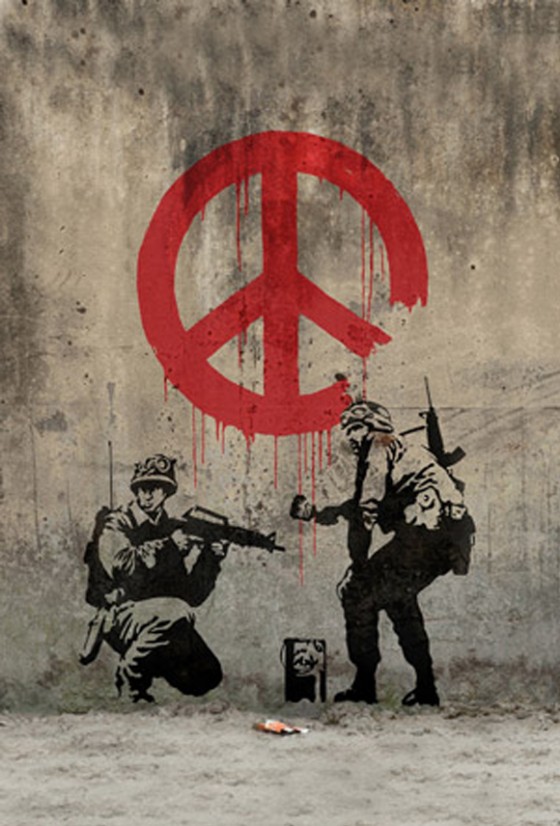Shanti Sena: The Peace Army of India
by Asha Devi Aryanayakam
Editor’s Preface: This article is taken from The War Resister, issue 92, Third Quarter 1961. We have posted a number of other articles on Shanti Sena, which may be accessed via our search function. Notes about the author, references, and acknowledgments are found at the end. JG

“Soldiers Painting Peace”; mural by Banksy; courtesy stencilrevolution.com
The conception of a Peace Brigade or a Peace Army was first placed before the Indian people by Gandhi in 1938. He was then engaged in the great experiment of reconstructing Indian national life through nonviolence. The movement for political independence was only a part of the story. The monster of communal tension had just begun to rear its ugly head and the Peace Army was Gandhi’s answer to the problem. With his characteristic straightforwardness, he placed his proposal in down-to-earth practical terms without any philosophical introduction.
As he wrote, ‘Some time ago I suggested the formation of a Peace Brigade (Shanti Sena), whose members would risk their lives in dealing with riots, especially communal. The idea was that this brigade should substitute for the police and even the military. This sounds ambitious. The achievement may prove impossible.’
Gandhi then suggested qualifications for the volunteers, which are mentioned by Donald Groom in his contribution to this issue of the War Resister [posted below under this date]. As Gandhi wrote, ‘Let no one understand from the foregoing that a nonviolent army is open only to those who strictly enforce in their lives all the implications of nonviolence. It is open to all those who accept the implications and make an ever increasing endeavour to observe them. There never will be an army of perfectly nonviolent people. It will be formed of those who will honestly endeavour to observe nonviolence.’ (Harijan, 21.7.1940.)
However, the Indian people were apparently not yet ready for this programme in the evolution of nonviolence. Gandhi with his passion for honesty admitted it himself. ‘Some time ago an attempt was made, at my instance, to form Shanti Dais (Peace Corps), but nothing came of it. This lesson, however, was learnt: that its membership, by the very nature of such organisations, could not be very large.’
There was, however, no place for frustration or disappointment in Gandhi’s experiments in nonviolence. The last years of his life and his glorious death, itself, were dedicated to the work of peacemaking in the areas of communal disturbances: East Bengal (now Bangladesh], Bihar and Delhi. We have, therefore, his example before us as the first “Soldier of Peace” or, the first “One-man Peace Brigade”. There were others involved too, of course, unknown soldiers of peace at their lonely posts, scattered here and there.
The second phase of our nonviolent movement began in 1951 under Vinoba Bhave’s leadership. The Peace Brigade idea, which had grown slowly from the living seed sown by Gandhi, put forth its shoots into the light when Vinoba enrolled the first five peace soldiers in the summer of 1957. Since then, the movement has developed slowly as an integral part of the Sarvodaya Movement, under the direct guidance of Vinoba. There is increasing recognition that in India and the world today, peacemaking or peace-building is the most urgent task before us, needing a band of dedicated, disciplined and fulltime workers.
The number in India is not yet very large, but the ultimate objective is an Army of 700,000 fulltime peace soldiers or Servants of Peace. They would be assisted by groups of Peace Associates in every village and every town ward. The Indian nonviolence workers are convinced that they cannot, and dare not, rest until they have carried the message of the Peace Army to every man and woman in India, and have established in every Indian home the Vessel of Peace (Shanti Patra), a humble earthen pot where the youngest member of the family will daily place a handful of grain or the lowest denomination coin as the symbol of the consent of the family to the Peace Army ideals. Even these humblest gifts would be sent to help towards the maintenance of the peace army.
What of the day-to-day programme for the ‘soldiers’ of the Peace Army? It should be a programme of service, directed towards combating injustice, oppression and fear in the political, social and economic fields, in individual and family life, in employer-employee relationships, and always through nonviolence. The Peace Army is fully engaged at all times, and not only in times of conflicts.
India’s Shanti Sena is only in its initial stage of development. It has yet to grow in quality and numbers, in disciplined service and understanding of world problems. We have yet to evolve techniques of recruitment, training and maintenance of this Army of Nonviolence. Yet we are working in the faith and hope that this is an answer to the challenge of the growing might of violence in the world today.
Reference: IISG/WRI Archive Box 117: Folder 3, Subfolder 1.
EDITOR’S NOTE: Asha Devi Aryanayakam (1901-1972) was a teacher and devoted Gandhian, having lived in Sevagram ashram in the 1930s. She taught at the Woman’s College in Benares, and was married to E. Aryanayakam, the private secretary of Rabindranath Tagore. She published two Gandhian works, The Teacher: Gandhi; and Shanti-Sena. We are grateful to WRI/London and their director Christine Schweitzer for their cooperation in our WRI project.




